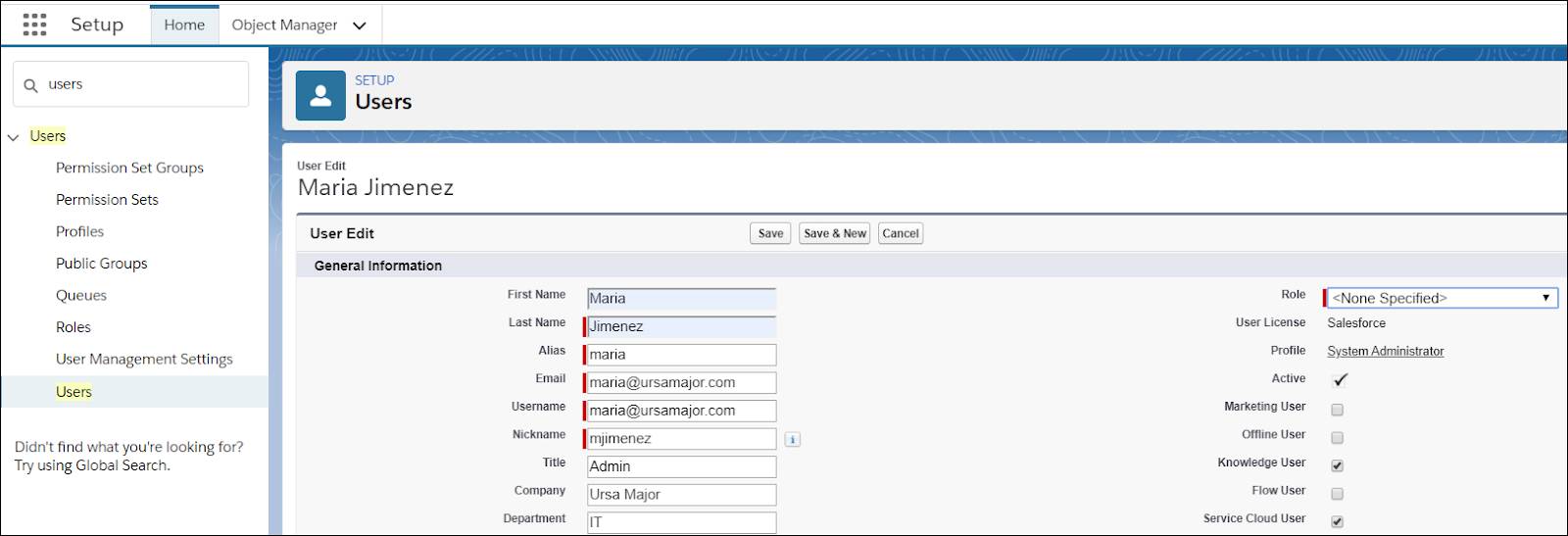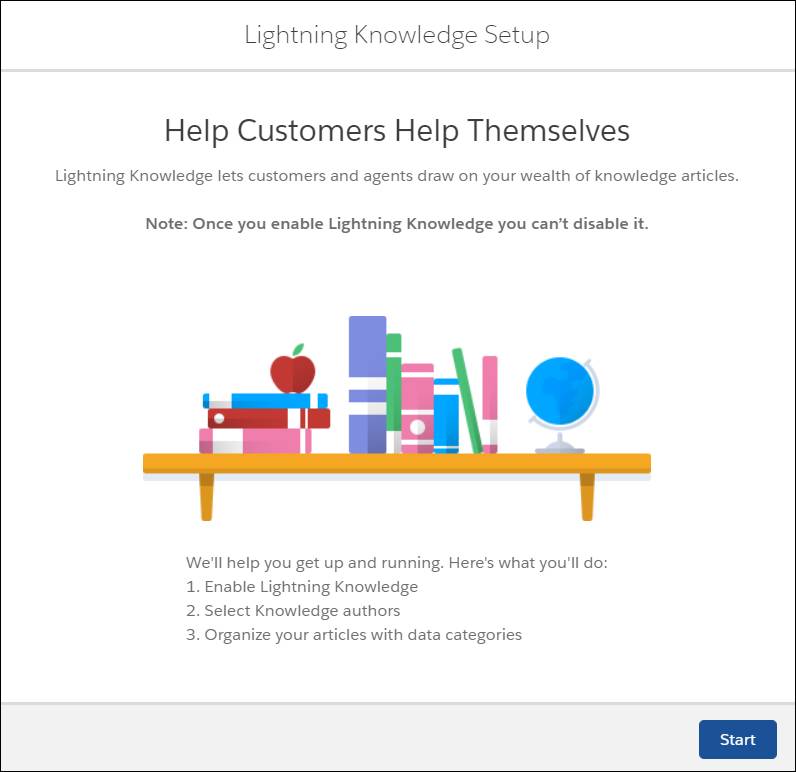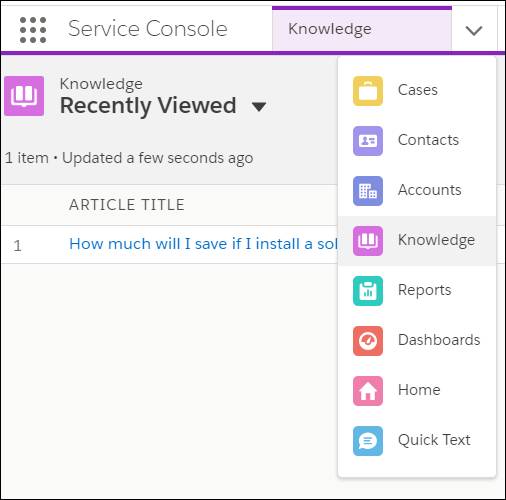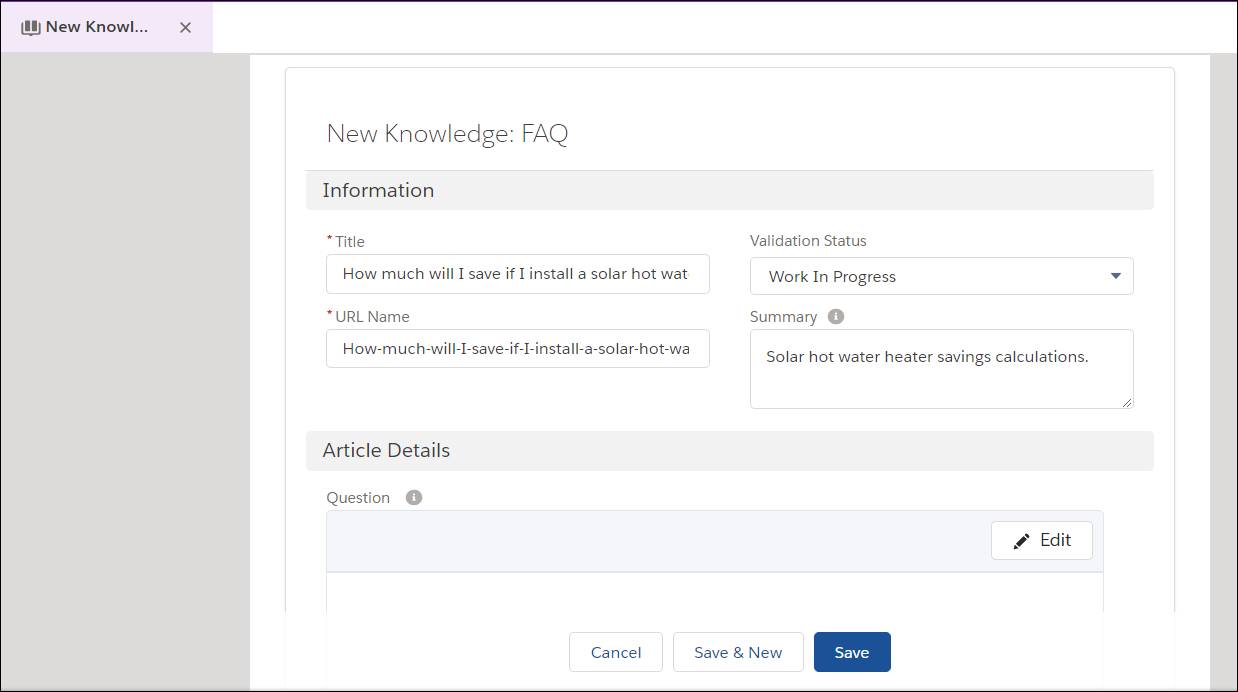Set Up a Simple Knowledge Base
Learning Objectives
After completing this unit, you’ll be able to:
- Identify and assign Knowledge User licenses.
- Enable Knowledge.
- Use the guided flow to set up Knowledge.
- Create and publish an article.
Count and Assign Knowledge Licenses to Users
Maria gets ready to purchase licenses for Lightning Knowledge. First, she has to figure out who needs them. Everyone including the office dog, Sunny? She researches further. It looks like Sunny and most of the reps don’t need licenses right away, because they read articles. They don’t create them. All internal users can read articles without a special license. If Sunny could read, he wouldn’t need one either.
But Ada and Maria do more than read articles. They create them. What kind of license do they need for that? Ursa Major uses Service Essentials. Lightning Knowledge User licenses are included in Service Essentials, so Maria doesn’t need to purchase any. (Check with your Salesforce account executive to determine your licensing needs.)
Once Knowledge is up and running, many people will write or edit articles, from reps and managers to subject matter experts and product evangelists. When that happens, each of them needs a license. Sunny still isn’t on Maria’s list, but at least he has his dog license.
Maria is ready to assign Knowledge User licenses to herself and Ada. Then they can start getting the knowledge base out of the planning stage and into the development stage. Here’s what Maria does.
- From the Setup menu (
 ), choose Setup.
), choose Setup.
- In the Quick Find box, enter Users.
- Click Users.
- Click the username. Maria clicks Jimenez, Maria.
- Click Edit and select Knowledge User.
- Click Save.

Assigning a Knowledge User license adds the Knowledge pages to Maria’s Setup.
Enable Knowledge
Maria needs to enable Knowledge for Ursa Major so she and Ada can start turning their plans into reality. She knows that once Knowledge is enabled, she can’t turn it off later. She gets to work.
- From the Setup menu (
 ), choose Setup.
), choose Setup.
- In the Quick Find box, enter Knowledge Settings and select Knowledge Settings.
- Select Enable Lightning Knowledge.
Set Up Knowledge with a Guided Flow
Maria discovers that she can use the Knowledge Setup Flow to automatically enable Knowledge, assign licenses to article authors, and set up data groups and categories. She wishes she’d found out about this easy time-saving tool before she enabled Knowledge and assigned a license to Ada. But now that she knows, she decides to run Lightning Knowledge Setup Flow to make sure everything has been done correctly and to set up data groups and categories. If she needs to make changes later, she can, but the Setup Flow gets her up and running quickly.
- From the Setup menu (
 ), choose Service Setup.
), choose Service Setup.
- To open the Lightning Knowledge Setup flow, click the Knowledge Setup tile.

- Click Start.
- In the search box, enter a Lightning Knowledge Author. Maria enters Ada.
- Select the author and click Next. Maria selects Ada Balewa.
- Enter your data group and data categories and click Next. Maria enters Home Solar Installation as the data group and Solar Hot Water Heater Installation as the data category.
- Click Finish.
Create Knowledge Articles
Everything is set up and Ada’s ready to create her first article, a question from her FAQ. It’s the first of many, and she wants to make sure that she gets it right. Let’s follow Ada as she creates her first article.
- From the main menu in the Service console, select Knowledge. If you need to get to the console, select it from the App Launcher.

- Click New.
- Choose the record type for the article. Ada chooses FAQ.
- Click Next.
- Enter the article title in the Title field. Ada enters How much will I save if I install a solar hot water heater?
- Click in the URL name field. Knowledge generates a URL based on the article title. You can change it, but Ada opts not to.
- Choose a Validation Status. Ada chooses Work in Progress.
- To show what the article is about, enter a summary. The summary appears in the search results. Ada enters Solar hot water heater savings calculations. Here’s Ada’s screen.

- Click Save.
Ada has created her first article! Well, not really. She still needs to enter the question and answer.
- In the Knowledge tab, click the article name. Ada clicks How much will I save if I install a solar hot water heater?
- Click Edit.
- Next to Question, click Edit.
- Enter the question. Ada enters: How much will I save if I install a solar hot water heater?
- Next to Answer, click Edit.
Note: You can set it up so that users can edit articles without having to click the Edit button. Go to the Knowledge Settings page and select Enable automatic loading of rich-text editor when editing an article.
- Enter the answer. Ada enters: Here in the Southwest, we have ample solar energy year-round, except for the few days when it rains. That means your solar hot water heater is always working for you. How much you save depends on how much hot water your household uses. For some households, that's up to 85% of your bill, but the average is around 50%.
- Click Save.
Later, Ada and Maria will set up an approval process to make sure that articles are properly reviewed. For example, articles written by trainees or ones that must stay in compliance with rules need to be reviewed. For now, Ada decides to publish this article on her own. Here’s how she does it.
- In the Knowledge tab, click the article. Ada clicks How much will I save if I install a solar hot water heater?
- Click Publish.
- Select when to publish the article. Ada selects Publish Now.
- Click Publish.
Ursa Major is ready to start populating its knowledge base. Maria and Ada have figured out what data they have, who needs to access it, and how to set up the knowledge base. Ada even already wrote and published the first article. They’re ready to bring the power of Lightning Knowledge to their teams. Are you?
Resources
- Salesforce Help: Edit Users
- Salesforce Help: Knowledge Settings
- Salesforce Help: Set Up Lightning Knowledge with a Guided Setup Flow
- Salesforce Help: Lightning Knowledge Setup Flow: What’s Next?
- Salesforce Help: Create and Edit Articles
